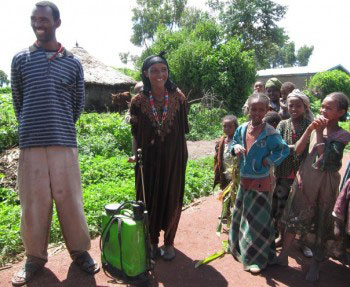
EL BATAN, Mexico (CIMMYT) — Until a few years ago, farmers Abdela and Bayisu Kadir grew “Kubsa,” a semi-dwarf bread wheat variety on their small landholding in the Ethiopian highlands known as the Roof of Africa.
The couple manage a 3-hectare farm, which is situated at an elevation of 2,400 meters (7,874 feet) in the Arsi region about 175 kilometers (110 miles) southeast of the capital Addis Ababa.
Kubsa, just one of 480 wheat varieties bred by 2014 World Food Prize laureate scientist Sanjaya Rajaram during his 40-year career, has had a long and successful run since it was first released in 1995.
The variety, developed by Rajaram at research stations operated by the International Maize and Wheat Improvement Center (CIMMYT), came from the high-yielding Atilla wheat breeding line he created in 1990.
By 2010, Kubsa was grown on 250,000 hectares (620,000 acres) of cropland in Ethiopia. Over time, as wheat rust disease fungi have mutated in the region, Kubsa has become vulnerable to yellow rust and stem rust, which can devastate crops leading to shriveled grain, yield losses and financial troubles for farmers.
“After yellow rust disease began to appear in our crop a few years ago, we switched to the Kakaba wheat variety,” said Bayisu Kadir, who has six children.
“Last year Kakaba gave us more than 5 (metric) tons of wheat per hectare (75 bushels per acre),” she added, explaining that her husband had sprayed their crop with fungicide to protect it from potential damage.
By 2012, the CIMMYT-derived variety Kakaba covered more than 200,000 hectares in Ethiopia, according to the online Wheat Atlas, and so far remains resistant to yellow rust.
CIMMYT is a member of the Borlaug Global Rust Initiative, an international consortium of more than 1,000 scientists from hundreds of institutions that works to reduce vulnerability to mutating rust diseases. CIMMYT continuously produces high-yielding disease-resistant wheat varieties.
BACKBONE GENES
Atilla, called Kubsa in Ethiopia, is a family of wheat varieties released by governments under different names in various countries. Its two main sister lines were widely adopted around the world.
One sister line, which became the leading variety for over a decade in the bread basket region of northwestern India, contains a combination of resistance genes including Sr31, Yr9 and Yr27, recognized by Rajaram as genes that provided resistance to both stem and yellow rusts.
The other sister variety carried the Yr27 gene and was widely cultivated in many wheat-growing countries. At one time, these two sister varieties were grown on about 8 million hectares throughout Africa, the Middle East and South Asia.
Overall, Rajaram’s adaptable, high-yielding wheat varieties are grown on more than 58 million hectares worldwide. He is credited with producing 480 wheat varieties, which have boosted worldwide yields by more than 180 million tons. These increased yields provide food to more than 1 billion people each year.
He also developed aluminum-tolerant varieties together with Brazilian researchers that were planted in acid soils, areas previously unable to grow wheat.
“Rajaram’s varieties led to more yield and better income for farmers, less yellow rust disease and less chemical application,” said Zuo Yuchun, a professor at the Sichuan Academy of Agricultural Science in China who collaborated with Rajaram for more than 20 years.
Rajaram is the 2014 World Food Prize Laureate for “advancing human development by improving the quality, quantity or availability of food in the world.” He received the award at the World Food Prize ceremony on October 16 in Des Moines, Iowa.
VITAL STAPLE CROP
Globally, wheat provides 20 percent of the world’s daily protein and calories. Production must grow 60 percent over the next 35 years to keep pace with demand, according to the Food and Agriculture Organization of the United Nations.
“The prodigious increase in wheat production through Dr. Rajaram’s work is a furtherance of the success of the ‘Green Revolution’,” said molecular scientist Kameswara Rao, formerly with India’s University of Agricultural Sciences in Dharwad and currently chair of the Foundation of Biotechnology Awareness and Education.
“The wheat varieties developed by Dr. Rajaram have been grown by both small- and large-scale farmers across a diverse range of agricultural environments in 51 countries, contributing to an enhancement of food security.”
The late CIMMYT scientist Norman Borlaug, who mentored Rajaram, led efforts to develop semi-dwarf wheat varieties in the mid-20th century that helped save more than 1 billion people in the developing world in what became widely known as the Green Revolution. Borlaug was awarded the 1970 Nobel Peace Prize for his work and subsequently initiated the World Food Prize.
INNOVATIVE BREEDING
Rajaram joined CIMMYT, which aims to sustainably increase maize and wheat productivity to ensure global food security and reduce poverty, in 1969. As head of CIMMYT wheat breeding, Rajaram increased yield potential 20 to 25 percent.
During his career, Rajaram visited farmers groups and cooperatives to teach them about new technologies, said Arun Joshi, CIMMYT senior wheat breeder for South Asia. He taught them tillage and seeding techniques.
“Rajaram’s participatory approach brought confidence among the farmers and they took more interest in their agriculture and new technologies,” Joshi said.
“Training was mostly delivered as roving seminars organized in farmers’ fields before the start of sowing, during sowing, about a month after sowing and at crop maturity. Such initiatives generated new leadership among farmers and helped faster dissemination of technology among less privileged farmers.”
Although Rajaram retired from CIMMYT in 2003, he continues to help train new wheat breeders.
“We’re grateful for the hundreds of new varieties of wheat that Dr. Rajaram has developed,” said U.S. Secretary of State John Kerry.
“These will deliver more than 200 million more tons of grain to global markets each year and Dr. Rajaram has helped to feed millions of people across the world through his lifetime of research and innovation.”
 Climate adaptation and mitigation
Climate adaptation and mitigation